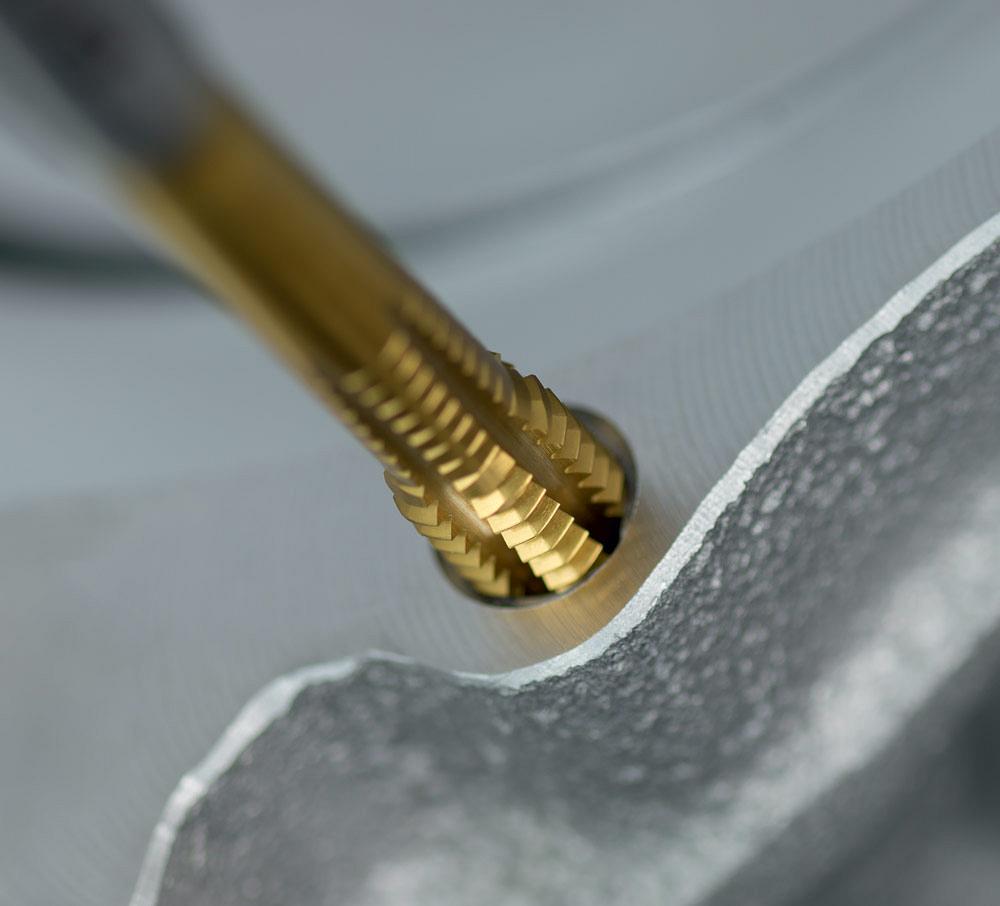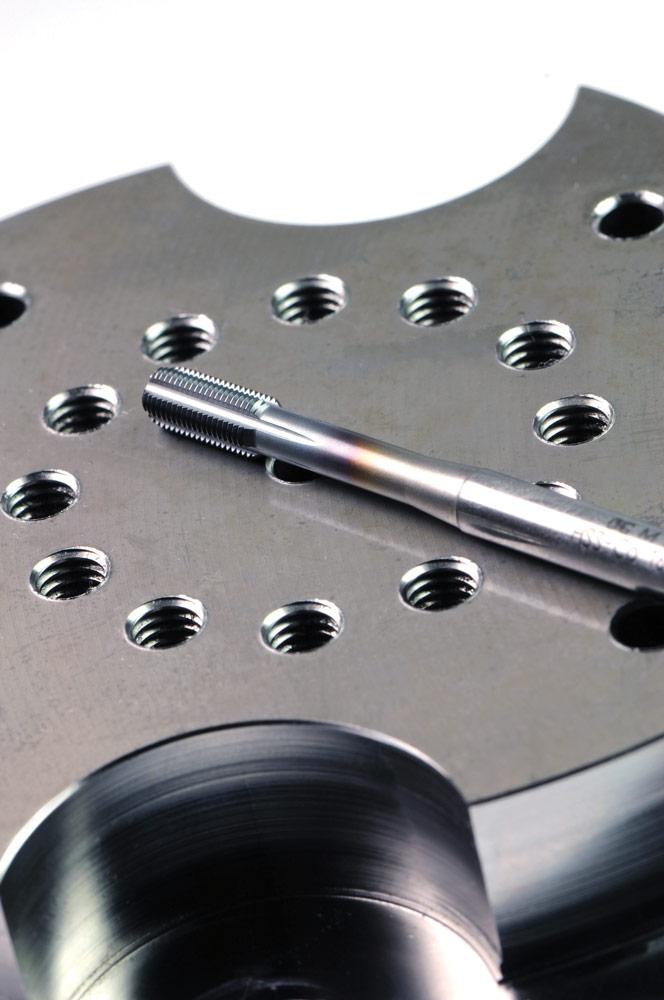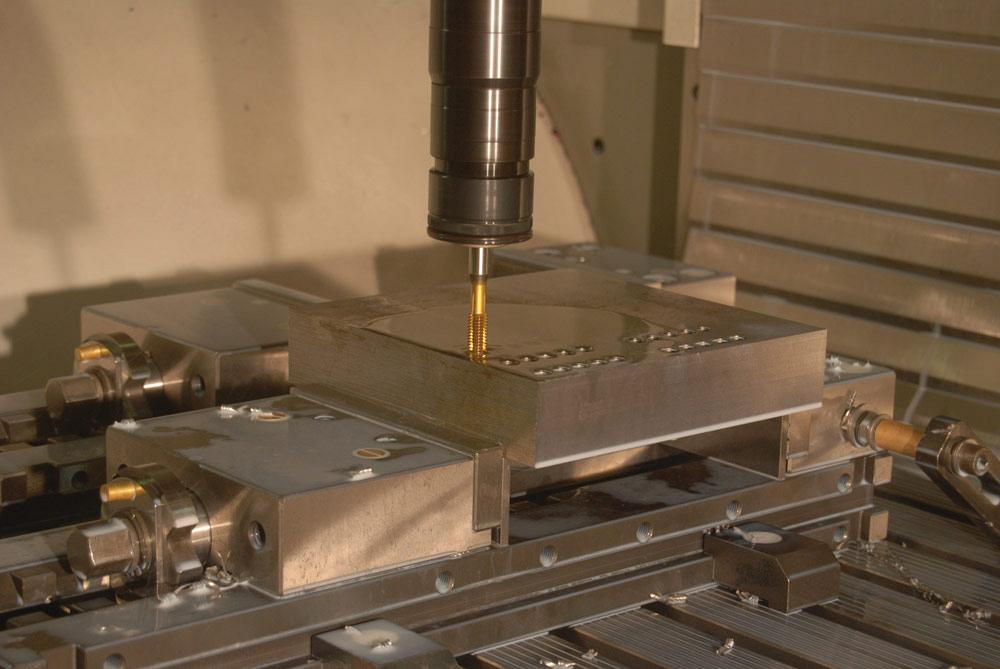Associate Editor
- FMA
- The Fabricator
- FABTECH
- Canadian Metalworking
Why cut when you can form?
Forming taps produce strong and cost-effective threads
- By Lindsay Luminoso
- July 12, 2021
- Article
- Cutting Tools

With forming, you have to control two dimensions simultaneously, which are the minor diameter and the pitch diameter. Emuge Corp.
Creating threads is a common practice in many machine shops. This part of the process takes place late in the game, often after quite a bit of work has been done to bring the component to near completion. This is why it is imperative to thread correctly. One misstep and the entire part could be scrapped, and no one wants this. The three common methods for threading internal holes are tapping, milling, and forming.
“It's very hard to entertain the idea of switching to thread forming if you’re not familiar with it or haven't been introduced to it in the past,” said Matthew Haid, application specialist, Dormer Pramet, Elgin, Ill. “Most people think that you have to use a cutting tap in a hole. Instead of cutting the threads, forming taps displace material flowing into the gaps of the teeth as opposed to cutting them.”
And while the cutting methods tend to be the most popular, thread forming does offer some significant advantages, depending on the application.
“One of the biggest differences is that forming taps do not create chips,” said Kyle Matsumoto, product engineer, OSG USA, St. Charles, Ill. “Chip evacuation can be a big challenge when threading, especially in deep holes, so not having chips is a strength of this method.”
With no chip production, this forming tends to offer a higher level of safety and productivity. It also tends to be much more accurate, producing the correct tolerances.
“It's also a stronger thread,” said Haid. “However, there are some limitations, like it does require more spindle power. And while it can be used for most industries, the food, medical, and aerospace sectors are exceptions.”
With forming, the tap rolls the material, producing a rabbit ear-like shape that includes a gap rather than a flat surface. This can be problematic for certain industries because the gaps can collect contaminants and particles.
“A forming tap tends to last three to 20 times longer than other methods,” said Haid. “Thread forming is the wave of the future, but I don't know if shops are always aware that this is a viable option. There's a bit of an upfront cost associated with it, but the extended tool life justifies the cost in many cases.”
All About the Hole
With forming, the predrilled hole size is extremely important to the overall accuracy of the threads. Many operators who are unfamiliar with forming may look to a standard or traditional tap drill chart, but forming has its own requirements. It can be challenging to find new references, but many cutting tool manufacturers can provide specifications, and looking through the Machinery’s Handbook can offer insights.
“The minor diameter cannot be controlled using forming taps, and therefore a tighter tolerance is required,” said Matsumoto. “If the drilled hole is too large or not as precise, this can limit the amount of material that is able to be displaced to properly form the thread. On the flip side, if the hole is too small, there will be too much material needing to be displaced, resulting in failure.”

Using a good predrill hole size and checking it constantly throughout the processes, especially if there are a lot of holes, can help create quality threads. OSG USA
Forming has its own unique drill size, which tends to be larger than the standard cutting tap size. For forming, you want to drill the minor diameter oversized so that it’s slightly larger than what it will be when finished. When the forming tap is ground dimensionally, it will displace the material, which will squeeze into the full file of the tool, bringing it to the minor and pitch diameter.
“With forming, you have to control two dimensions simultaneously, which are the minor diameter and the pitch diameter,” said Mark Hatch, product director, Emuge Corp., West Boylston, Mass. “And this is different than the cutting method, where you drill the final size of the minor diameter prior to tapping. The hole size is finished prior to a cutting tap entering the hole. When a cutting tap is ground, the minor diameter is the clearance so there is no contact with the minor.”
If there isn’t good, smooth flow of the material, it can become very difficult to control the size and create the correct thread.
The experts recommended using a good predrill hole size and checking it constantly throughout the processes, especially if there are a lot of holes.
“You definitely want to make sure that the first hole is the same diameter as the last hole,” said Haid. “That way, you have a consistent hole all the way through so that you can then form. I would also recommend checking the hole and threads after the first form. Do one first and check it right after, so you can save yourself a lot of downtime.”
Material Matters
Material type and hardness play significant roles in the effectiveness of forming. If the material is too brittle or hard, it can make the forming process impossible.
“Aluminum, stainless steel, carbon steel, some alloys, and basically any material up to 40 HRC work well with this method,” said Matsumoto. “We have tested forming on things like heat-resistant superalloys, specifically INCONEL 718, and it worked fine. The problem with this is that these types of materials are usually used in industries where thread forming is not widely accepted, so it doesn’t really make sense to produce forming taps for these applications unless it is a special tool.”
Workpiece material must have the ability to flow to be able to create the thread profile. A cutting method should be used for materials like cast iron – which doesn’t flow well – to produce threads.
“Titanium can also be a challenge due to its very low thermal conductivity, meaning that it doesn’t absorb heat very well,” said Haid. “And without the necessary heat, the material can have a hard time flowing into the thread space. But for steels and aluminums, it's one of the strongest and most accurate ways possible to create a thread.”
The experts noted that for small-diameter threading applications in difficult materials, cutting threads can be problematic because the chips tend to be very strong and do not evacuate easily, leading to tap breakage. This is not an issue with forming.

Forming creates a stronger thread but it requires more spindle power. While forming is acceptable for most industries, the food, medical, and aerospace sectors are exceptions. Dormer Pramet
“Another advantage of forming is that it is not shearing the grain structure,” said Hatch. “So when it displaces the material, it compresses the root of the thread profile and you get very smooth thread flanks, providing increased dynamic strength.”
Coating technology also plays an important role in the performance of the forming tap. The workpiece material will dictate the appropriate coating needed for the tool.
“Because of chemical interactions between coatings and the composition of the materials, they have to be matched properly,” said Hatch. “For example, if I were to use a TiN-coated forming tap in a 6061-T6 aluminum, the TiN coating would actually have a chemical interaction with the metal and would start bonding to the tool. This would yield a very poor result and low tool life. So, what you would use in aluminum is very different than what should be used in stainless steel and so on.”
Machining Factors
“Thread milling and thread tapping have lower torque specifications because of the cutting action,” said Matsumoto. “However, with thread forming, the torque needed to displace the material is much greater. This means that shops may need to consider a larger, stronger machine.”
The experts agree that one of the errors shops make is underestimating the power required to drive a form tap.
“A forming tap requires about twice the torque compared to a cutting method,” said Hatch. “As the tap sizes get bigger, it makes less sense to use forming. By the time you get ¾ to 1 in. or above, the use of forming tends to drop because it requires a machine that can produce a lot of torque in order to efficiently run it.”
This method is well-suited for high-production CNC machining, which can achieve that repeatability and consistent threads.
“It’s also so important to have a nice rigid setup,” said Haid. “The machine needs to have the power, there needs to be a strong toolholder, and the workpiece needs to be secure. Everything has to be dialed in really well.”
The recommended speeds are going to be a lot faster than for a traditional cutting tap. This can be intimidating, especially when you aren’t hearing and seeing the usual cues that you get with cutting methods.
Hatch noted that one of the strengths of forming is that it works well for lights-out operations.

One of the strengths of thread forming is that because it doesn’t produce chips, it works well for lights-out operations. Emuge Corp.
“Because there are no chips, you are able to get a very consistent, predictable thread on unattended operations,” he said. “If you get a very good-quality tool, you can also get a very predictable tool life result. This will help shops move into the automated processes and allow them to run unattended.”
Keep It Cool
“During the threading process, heat enters the workpiece, tool, and chips,” said Matsumoto. “However, with no chips, heat penetrates the tool and material at a much higher rate, which can lead to issues. This is why coolant and lubrication are so important. Also, some forming taps are designed with a unique lobe geometry that helps reduce cutting forces, leading to a reduction in heat generation.”
External coolant can be efficient for this method, as most taps are designed with channels to allow lubricant to access various parts of the tool and workpiece.
“Forming does require a higher lubricity characteristic from the coolant or straight oil,” said Hatch. “It's a high-friction process because it is pushing the material into a form rather than shearing it. You have to be more conscious of the concentration of the coolant. We typically recommend a 10 per cent concentration in order to have sufficient lubricity to keep the tap running smoothly and material flowing smoothly.”
Thread Check
Checking to ensure that holes and threads meet specifications is important to do throughout the process.
“One of the top 10 questions we get asked is about inspection and whether shops can use a GO/NO-GO gauge,” said Haid. “Gauging is no different from one method to the other. It is the basis of all inspection. The core hole and minor diameter also need to be checked using a similar method to that of cutting.”
Dormer Pramet, www.dormerpramet.com
Emuge Corp., www.emuge.com
OSG USA, www.osgtool.com
About the Author

Lindsay Luminoso
1154 Warden Avenue
Toronto, M1R 0A1 Canada
Lindsay Luminoso, associate editor, contributes to both Canadian Metalworking and Canadian Fabricating & Welding. She worked as an associate editor/web editor, at Canadian Metalworking from 2014-2016 and was most recently an associate editor at Design Engineering.
Luminoso has a bachelor of arts from Carleton University, a bachelor of education from Ottawa University, and a graduate certificate in book, magazine, and digital publishing from Centennial College.
Related Companies
subscribe now


Keep up to date with the latest news, events, and technology for all things metal from our pair of monthly magazines written specifically for Canadian manufacturers!
Start Your Free Subscription- Trending Articles
Automating additive manufacturing

CTMA launches another round of Career-Ready program

Collet chuck provides accuracy in small diameter cutting

Sandvik Coromant hosts workforce development event empowering young women in manufacturing

GF Machining Solutions names managing director and head of market region North and Central Americas

- Industry Events
MME Winnipeg
- April 30, 2024
- Winnipeg, ON Canada
CTMA Economic Uncertainty: Helping You Navigate Windsor Seminar
- April 30, 2024
- Windsor, ON Canada
CTMA Economic Uncertainty: Helping You Navigate Kitchener Seminar
- May 2, 2024
- Kitchener, ON Canada
Automate 2024
- May 6 - 9, 2024
- Chicago, IL
ANCA Open House
- May 7 - 8, 2024
- Wixom, MI















